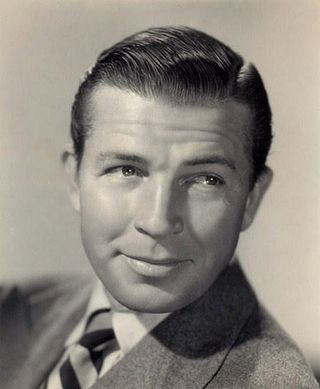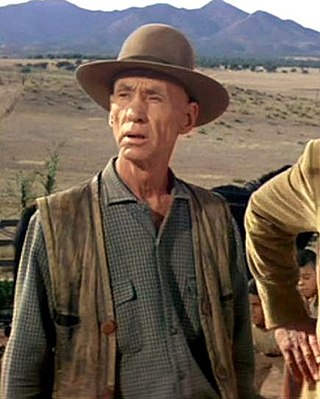
The Searchers is a 1956 American Technicolor VistaVision epic Western film directed by John Ford and written by Frank S. Nugent, based on the 1954 novel by Alan Le May. It is set during the Texas-Native American wars, and stars John Wayne as a middle-aged Civil War veteran who spends years looking for his abducted niece, accompanied by his adopted nephew.

William Broderick Crawford was an American actor. He is best known for his portrayal of Willie Stark in the film All the King's Men (1949), which earned him an Academy Award and a Golden Globe Award. Often cast in tough-guy roles, he later achieved recognition for his starring role as Dan Mathews in the crime television series Highway Patrol (1955–1959).

Stuart Maxwell Whitman was an American actor, known for his lengthy career in film and television. Whitman was born in San Francisco and raised in New York until the age of 12, when his family relocated to Los Angeles. In 1948, Whitman was discharged from the Corps of Engineers in the U.S. Army and started to study acting and appear in plays. From 1951 to 1957, Whitman had a streak working in mostly bit parts in films, including When Worlds Collide (1951), The Day the Earth Stood Still (1951), Barbed Wire (1952) and The Man from the Alamo (1952). On television, Whitman guest-starred in series such as Dr. Christian, The Roy Rogers Show, and Death Valley Days, and also had a recurring role on Highway Patrol. Whitman's first lead role was in John H. Auer's Johnny Trouble (1957).

Joseph Leo Mankiewicz was an American film director, screenwriter, and producer. Mankiewicz had a long Hollywood career, and won both the Academy Award for Best Director and the Academy Award for Best Adapted Screenplay in consecutive years for A Letter to Three Wives (1949) and All About Eve (1950), the latter of which was nominated for 14 Academy Awards and won six.

Valentina Cortese, sometimes credited as Valentina Cortesa, was an Italian film and theatre actress. In her 50 years spanning career, she appeared in films of Italian and international directors like Michelangelo Antonioni, Federico Fellini, Franco Zeffirelli, François Truffaut, Joseph L. Mankiewicz and others.

Bruce Cabot was an American film actor, best remembered as Jack Driscoll in King Kong (1933) and for his roles in films such as The Last of the Mohicans (1936), Fritz Lang's Fury (1936), and the Western Dodge City (1939). He was also known as one of "Wayne's Regulars", appearing in a number of John Wayne films beginning with Angel and the Badman (1947), and concluding with Big Jake (1971).

Ina Balin was an American stage, film, and television actress. She is best known for her role in the film From the Terrace (1960), for which she received two Golden Globe Award nominations and won one for Most Promising Newcomer – Female.

Henry George Carey Jr. was an American actor. He appeared in more than 90 films, including several John Ford Westerns, as well as numerous television series.

Lane Chandler was an American actor specializing mainly in Westerns.

Thomas Frank Mankiewicz was an American screenwriter, director, and producer of motion pictures and television whose credits included James Bond films and his contributions to Superman: The Movie (1978) and the television series Hart to Hart. He was the son of Joseph Mankiewicz and nephew of Herman Mankiewicz.

Charles Henry Pywell Daniell was an English actor who had a long career in the United States on stage and in cinema. He came to prominence for his portrayal of villainous roles in films such as Camille (1936), The Great Dictator (1940), The Philadelphia Story (1940) and The Sea Hawk (1940). Daniell was given few opportunities to play sympathetic or 'good guy' roles; an exception was his excellent portrayal of Franz Liszt in the biographical film of Robert and Clara Schumann, Song of Love (1947). His name is sometimes spelled "Daniel".

Robert E. Bray was an American film and television actor known for playing the forest ranger Corey Stuart in the CBS series Lassie, He also starred in Stagecoach West and as Mike Hammer in the movie version of Mickey Spillane's novel My Gun Is Quick (1957).

Patrick John Morrison, better known by his stage name Patrick Wayne, is an American actor. He is the second son of movie star John Wayne and his first wife, Josephine Alicia Saenz. He made over 40 films, including eleven with his father.

Hank Worden was an American cowboy-turned-character actor who appeared in many Westerns, including many John Ford films such as The Searchers and the TV series The Lone Ranger.
George Sherman was an American film director and producer of low-budget Western films. One obituary said his "credits rival in number those of anyone in the entertainment industry."
The Comancheros were a group of 18th- and 19th-century traders based in northern and central New Mexico. They made their living by trading with the nomadic Great Plains Indian tribes in northeastern New Mexico, West Texas, and other parts of the southern plains of North America. The name "Comancheros" comes from the Comanche tribe, in whose territory they traded. They traded manufactured goods, flour, tobacco, and bread for hides, livestock and slaves from the Comanche. As the Comancheros did not have regular access to weapons and gunpowder, there is disagreement about how much they traded these with the Comanche.
Darby's Rangers is a 1958 American war film directed by William Wellman and starring James Garner as William Orlando Darby, who organizes and leads the first units of United States Army Rangers during World War II. The movie was shot by Warner Brothers Studios in black and white, to match wartime stock footage included in the production. The film was inspired by the 1945 book Darby's Rangers: An Illustrated Portrayal of the Original Rangers, by Major James J. Altieri, himself a veteran of Darby's force. The supporting cast features Jack Warden and Stuart Whitman.

Charles Hugh Roberson was an American actor and stuntman.

John Dierkes was an American actor who appeared in a number of classic Hollywood films. Before becoming an actor, he had been an economist.
Stuart Whitman, born Stuart Maxwell Whitman, was an American actor, known for his lengthy career in film and television. Whitman was born in San Francisco and raised in New York until his family relocated to Los Angeles. In 1948, Whitman was discharged from the Corps of Engineers in the U.S. Army and started to study acting. From 1951 to 1957, Whitman had a streak working in mostly bit parts in films, including When Worlds Collide (1951), The Day the Earth Stood Still (1951), Barbed Wire (1952), and The Man from the Alamo (1952). On television, Whitman guest-starred in series such as Dr. Christian, The Roy Rogers Show, and Death Valley Days, and also had a recurring role on Highway Patrol. Whitman's first lead role was in John H. Auer's Johnny Trouble (1957).

















